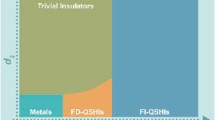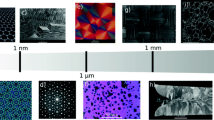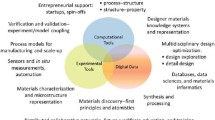Abstract
Materials informatics employs techniques, tools, and theories drawn from the emerging fields of data science, internet, computer science and engineering, and digital technologies to the materials science and engineering to accelerate materials, products and manufacturing innovations. Manufacturing is transforming into shorter design cycles, mass customization, on-demand production, and sustainable products. Additive manufacturing or 3D printing is a popular example of such a trend. However, the success of this manufacturing transformation is critically dependent on the availability of suitable materials and of data on invertible processing–structure–property–performance life cycle linkages of materials. Experience suggests that the material development cycle, i.e. the time to develop and deploy new material, generally exceeds the product design and development cycle. Hence, there is a need to accelerate materials innovation in order to keep up with product and manufacturing innovations. This is a major challenge considering the hundreds of thousands of materials and processes, and the huge amount of data on microstructure, composition, properties, and functional, environmental, and economic performance of materials. Moreover, the data sharing culture among the materials community is sparse. Materials informatics is key to the necessary transformation in product design and manufacturing. Through the association of material and information sciences, the emerging field of materials informatics proposes to computationally mine and analyze large ensembles of experimental and modeling datasets efficiently and cost effectively and to deliver core materials knowledge in user-friendly ways to the designers of materials and products, and to the manufacturers. This paper reviews the various developments in materials informatics and how it facilitates materials innovation by way of specific examples.



Similar content being viewed by others
References
Adams, B. L., Kalidindi, S. R., & Fullwood, D. (2012). Microstructure sensitive design for performance optimization. Oxford: Butterworth-Heinemann.
Agrawal, A., & Choudhary, A. (2016). Perspective: Materials informatics and big data: Realization of the fourth paradigm of science in materials science. APL Materials, 4(5), 053208. https://doi.org/10.1063/1.4946894.
Agrawal, A., Deshpande, P. D., Cecen, A., Gautham, B. P., Choudhary, A. N., & Kalidindi, S. R. (2014). Exploration of data science techniques to predict fatigue strength of steel from composition and processing parameters. Integrating Materials and Manufacturing Innovation, 3, 8. https://doi.org/10.1186/2193-9772-3-8.
Astrup, T., Møller, J., & Fruergaard, T. (2009). Incineration and co-combustion of waste: Accounting of greenhouse gases and global warming contributions. Waste Management & Research, 27(8), 789–799. https://doi.org/10.1177/0734242X09343774.
Balachandran, P. V., Xue, D., Theiler, J., Hogden, J., & Lookman, T. (2016). Adaptive strategies for materials design using uncertainties. Scientific Reports, 6 (1966).
Bergamaschi, E., Murphy, F., Poland, C. A., Mullins, M., Costa, A. L., Mcalea, E., et al. (2015). Impact and effectiveness of risk mitigation strategies on the insurability of nanomaterial production: Evidences from industrial case studies. Wiley Interdisciplinary Reviews: Nanomedicine and Nanobiotechnology, 7(6), 839–855. https://doi.org/10.1002/wnan.1340.
Brough, D. B., Wheeler, D., Warren, J., & Kalidindi, S. R. (2016). Microstructure-based knowledge systems for capturing process-structure evolution linkages. Current Opinion in Solid State & Materials Science, 21, 129–140.
Brownlee, J. (2013) A tour of machine learning algorithms. http://machinelearningmastery.com/a-tour-of-machine-learning-algorithms/.Accessed 2012.
Carrete, J., Li, W., Mingo, N., Wang, S., & Curtarolo, S. (2014). Finding unprecedentedly low-thermal-conductivity half-Heusler semiconductors via high-throughput materials modeling. Physical Review X, 4, 011019.
Çeçen, A., Fast, T., Kumbur, E. C., & Kalidindi, S. R. (2014). A data-driven approach to establishing microstructure-property relationships in porous transport layers of polymer electrolyte fuel cells. Journal of Power Sources, 245, 144–153.
Cerri, D., & Terzi, S. (2016). Proposal of a toolset for the improvement of industrial systems’ lifecycle sustainability through the utilization of ICT technologies. Computers in Industry, 81, 47–54. https://doi.org/10.1016/j.compind.2015.09.003.
Corona, A., Madsen, B., Hauschild, M. Z., & Birkved, M. (2016). Natural fibre selection for composite eco-design. CIRP Annals Manufacturing Technology, 65(1), 13–16. https://doi.org/10.1016/j.cirp.2016.04.032.
de Jong, M., Chen, W., Notestine, R., Persson, K., Ceder, G., Jain, A., et al. (2016). A statistical learning framework for materials science: Application to elastic moduli of k-nary inorganic polycrystalline compounds. Scientific Reports, 6, 34256. https://doi.org/10.1038/srep34256.
de Pablo, J. J., Jones, B., Kovacs, C. L., Ozolins, V., & Ramirez, A. P. (2014). The materials genome initiative, the interplay of experiment, theory and computation. Current Opinion in Solid State and Materials Science, 18(2), 99–117. https://doi.org/10.1016/j.cossms.2014.02.003.
Dean, J. (1990). Lange’s handbook of chemistry. Material and Manufacturing Process, 5(4), 687–688.
Dima, A., Bhaskarla, S., Becker, C., Brady, M., Campbell, C., Dessauw, P., et al. (2016). Informatics infrastructure for the materials genome initiative. JOM, 68(8), 2053–2064. https://doi.org/10.1007/s11837-016-2000-4.
Efron, B. (1983). Estimating the error rate of a prediction rule: Improvement on cross-validation. Journals of American Statistical Association, 78, 316–331.
Friedman, J. (2001). Greedy boosting approximation: A gradient boosting machine. Annals of Statistics, 29, 1189–1232. https://doi.org/10.1214/aos/1013203451.
Fischer, C. C., Tibbetts, K. J., Morgan, D., & Ceder, G. (2006). Predicting crystal structure by merging data mining with quantum mechanics. Nature Materials, 5(8), 641–646.
Fürnkranz, J., Gamberger, D., & Lavrač, N. (2012). Foundations of rule learning. Berlin: Springer.
Gen, M., & Cheng, R. (1997). Genetic algorithms and engineering design. New York: Wiley.
Ghiringhelli, L. M., Vybiral, J., Levchenko, S. V., Draxl, C., & Scheffler, M. (2014). Big data of materials science: Critical role of the descriptor. Physical Review Letters, 114(10), 105503.
Grant, G. B., Seager, T. P., Massard, G., & Nies, L. (2010). Information and communication technology for industrial symbiosis. Journal of Industrial Ecology, 14, 740–753.
Gupta, A., Cecen, A., Goyal, S., Singh, A. K., & Kalidindi, S. R. (2015). Structure-property linkages using a data science approach: Application to a non-metallic inclusions/steel composite system. Acta Materialia, 91, 239–254.
Hervy, M., Evangelisti, S., Lettieri, P., & Lee, K.-Y. (2015). Life cycle assessment of nanocellulose-reinforced advanced fibre composites. Composites Science and Technology, 118, 154–162. https://doi.org/10.1016/j.compscitech.2015.08.024.
Jain, A., Persson, K. A., & Ceder, G. (2016). Research Update: The materials genome initiative: Data sharing and the impact of collaborative ab initio databases. APL Materials, 4(5), 053102. https://doi.org/10.1063/1.4944683.
Kalidindi, S. R. (2015). Hierarchical materials informatics. Oxford: Butterworth Heinemann.
Kalidindi, S. R., Niezgoda, S. R., Landi, G., Vachhani, S., & Fast, T. (2010). A novel framework for building materials knowledge systems. Computers, Materials & Continua, 17, 103–125.
Kalidindi, S. R., Brough, D. B., Li, S., Cecen, A., Blekh, A. L., Congo, F. Y. P., et al. (2016a). Role of materials data science and informatics in accelerated materials innovation. MRS Bulletin, 41(8), 596–602. https://doi.org/10.1557/mrs.2016.164.
Kalidindi, S. R., & De Graef, M. (2015). Materials data science: Current status and future outlook, annual review of materials research. Annual Reviews, 45(1), 171–193. https://doi.org/10.1146/annurev-matsci-070214-020844.
Kalidindi, S. R., Medford, A. J., & McDowell, D. L. (2016b). Vision for data and informatics in the future materials innovation ecosystem. JOM, 68, 2126–2137.
Kaufman, L., & Ågren, J. (2014). CALPHAD, first and second generation—Birth of the materials genome. Scripta Materialia, 70, 3–6. https://doi.org/10.1016/j.scriptamat.2012.12.003.
Khosravani, A., Cecen, A., & Kalidindi, S. R. (2017). Development of high throughput assays for establishing process-structure-property linkages in multiphase polycrystalline metals: Application to dual-phase steels. Acta Materialia, 123, 55–69.
Landi, G., Niezgoda, S. R., & Kalidindi, S. R. (2010A). Multi-scale modeling of elastic response of three-dimensional voxel-based microstructure datasets using novel DFT-based knowledge systems. Acta Materialia, 58, 2716–2725.
Landi, G., & Kalidindi, S. R. (2010B). Thermo-elastic localization relationships for multi-phase composites. Computers, Materials & Continua, 16, 273–293.
Le, T. C., & Winkler, D. A. (2016). Discovery and optimization of materials using evolutionary approaches. Chemical Reviews, 116(10), 6107–6132. https://doi.org/10.1021/acs.chemrev.5b00691.
Lookman, T., Balachandran, P. V., Xue, D., Hogden, J., & Theiler, J. (2016). Statistical inference and adaptive design for materials discovery. Current Opinion in Solid State and Materials Science,. https://doi.org/10.1016/j.cossms.2016.10.002.
Low, J. S. C., Lu, W. F., & Song, B. (2014). Methodology for an integrated life cycle approach to design for environment. Key Engineering Materials,. https://doi.org/10.4028/www.scientific.net/KEM.572.20.
Lu, B., Zhang, J., Xue, D., & Gu, P. (2011). Systematic lifecycle design for sustainable product development. Concurrent Engineering,. https://doi.org/10.1177/1063293X11424513.
McDowell, D. L., & Kalidindi, S. R. (2016). The materials innovation ecosystem: A key enabler for the materials genome initiative. MRS Bulletin, 41(4), 326–337. https://doi.org/10.1557/mrs.2016.61.
Mitchell, T. M. (1997). Machine Learning. New York City: McGraw Hill.
Mulholland, G. J., & Paradiso, S. P. (2016). Perspective: Materials informatics across the product lifecycle—Selection, manufacturing, and certification. APL Materials, 4(5), 053207. https://doi.org/10.1063/1.4945422.
National Science and Technology Council. (2011). Materials genome initiative for global competitiveness. Washington: National Science and Technology Council.
NISP. (2015a). A brief introduction to CRISP. National Industrial Symbiosis Programme. http://sdrn.policystudiesinstitute.org.uk/sites/default/files/events/Paul Innes CRI (Accessed October 25, 2015).
NISP. (2015b). Confidentiality Charter CRISP. National Industrial Symbiosis Programme. Available at: https://www.tees.ac.uk/docs/DocRepo/Clemance/NISPConfidentialtyCharter.pdf (Accessed: 26 October 2015).
NIST. (2013). Materials informatics. National Institute of Standards and Technology. https://www.nist.gov/programs-projects/materials-informatics. Accessed October 30, 2016.
Panchal, J. H., Kalidindi, S. R., & McDowell, D. L. (2013). Key computational modeling issues in integrated computational materials engineering. Journal of Computer-Aided Design, 45, 4–25.
Peng, H., Long, F., & Ding, C. (2005). Feature selection based on mutual information: criteria of max-dependency, max-relevance, and min-redundancy. IEEE Transactions on Pattern Analysis & Machine Intelligence, 27(8), 1226–1238. https://doi.org/10.1109/TPAMI.2005.159.
Phillips, C. L., & Littlewood, P. (2016). Preface: Special topic on materials genome. APL Materials, 4(5), 2014–2016. https://doi.org/10.1063/1.4952608.
Puchala, B., Tarcea, G., Marquis, E. A., Hedstrom, M., Jagadish, H. V., & Allison, J. E. (2016). The materials commons: A collaboration platform and information repository for the global materials community. JOM, 68(8), 2035–2044. https://doi.org/10.1007/s11837-016-1998-7.
Quinlan, J. R. (1993). C4.5: Programs for machine learning. San Mateo, CA: Morgan Kaufmann.
Raabe, B., Low, J. S. C., Juraschek, M., Herrmann, C., Tjandra, T. B., Ng, Y. T., et al. (2017). Collaboration platform for enabling industrial symbiosis? Application of the by-product exchange network model. Procedia CIRP, 61, 263–268. https://doi.org/10.1016/j.procir.2016.11.225.
Raccuglia, P., Elbert, K. C., Adler, P. D. F., Falk, C., Wenny, M. B., Mollo, A., et al. (2016). Machine-learning-assisted materials discovery using failed experiments. Nature, 533(7601), 73–76. https://doi.org/10.1038/nature17439.
Rajan, Jose, & Seeram, Ramakrishna, (2018). Materials 4.0: Materials big data enabled materials discovery. Applied Materials Today. https://doi.org/10.1016/j.apmt.2017.12.015
Rajan, K. (2015). Materials informatics: The materials gene and big data. Annual Review of Materials Research, 45(1), 153–169. https://doi.org/10.1146/annurev-matsci-070214-021132.
Rodgers, J. R., & Cebon, D. (2006). Materials informatics. MRS Bulletin, 31(12), 975–980. https://www.cambridge.org/core/article/materials-informatics/4DDA16B3B93C616EBAE618445488A09B.
Samuel, A. L. (1967). Some studies in machine learning using the game of checkers. IBM Journal of Research and Development, 11(6), 601–617.
Sanvito, S., Oses, C., Xue, J., Tiwari, A., Zic, M., Archer, T., et al. (2017). Accelerated discovery of new magnets in the Heusler alloy family. Science Advances, 3, e1602241.
Shalev-Shwartz, S. (2011). Online learning and online convex optimization. Foundations and Trends in Machine Learning., 4(2), 107–194. https://doi.org/10.1561/2200000018.
Song, B., Yeo, Z., Low, J. S. C., Koh, D. J., Kurle, D., Cerdas, F., et al. (2015). A big data analytics approach to develop industrial symbioses in large cities. Procedia CIRP, 29, 450–455. https://doi.org/10.1016/j.procir.2015.01.066.
Tibshirani, R. (1996). Regression shrinkage and selection via the lasso. Journal of the Royal Statistical Society. Series B (Methodological), 58(1), 267–88. http://www.jstor.org/stable/2346178.
Vapnik, V. (1995). The nature of statistical learning theory. New York: Springer.
Vapnik, V. (1998). Statistical learning theory. New York: Wiley.
Wang, Z., et al. (2014). Integrated materials design and informatics platform within the materials genome framework. Chinese Science Bulletin, 59(15), 1755–1764. https://doi.org/10.1007/s11434-014-0225-6.
Xiong, P., Ji, X., Zhao, X., Lv, W., Liu, T., & Lu, W. (2015). Materials design and control synthesis of the layered double hydroxide with the desired basal spacing. Chemometrics and Intelligent Laboratory Systems, 144, 11–16. https://doi.org/10.1016/j.chemolab.2015.03.005.
Xue, D., Balachandran, P. V., Hogden, J., Theiler, J., Xue, D., & Lookman, T. (2016). Accelerated search for materials with targeted properties by adaptive design. Nature Communications, 7, 11241.
Xue, D., Xue, D., Yuan, R., Zhou, Y., Balachandran, P. V., Ding, X., et al. (2017). An informatics approach to transformation temperatures of NiTi-based shape memory alloys. Acta Materialia, 125, 532–541. https://doi.org/10.1016/j.actamat.2016.12.009.
Yabansu, Y. C., & Kalidindi, S. R. (2015). Representation and calibration of elastic localization kernels for a broad class of cubic polycrystals. Acta Materialia, 94, 26–35.
Yabansu, Y. C., Patel, D. K., & Kalidindi, S. R. (2014). Calibrated localization relationships for elastic response of polycrystalline aggregates. Acta Materialia, 81, 151–160.
Yabansu, Y. C., Steinmetz, P., Hotzer, J., Kalidindi, S. R., & Nestler, B. (2017). Extraction of reduced-order process-structure linkages from phase-field simulations. Acta Materialia, 124, 182–194.
Zhang, H. C., Li, J., Shrivastava, P., Whitley, A., & Merchant, M. E. (2004). A web-based system for reverse manufacturing and product environmental impact assessment considering enf-of-life dispositions. CIRP Annals Manufacturing Technology, 53(1), 5–8. https://doi.org/10.1016/S0007-8506(07)60632-5.
Zhao, Y. H., Abraham, M. H., & Zissimos, A. M. (2003). Determination of McGowan volumes for ions and correlation with van der Waals volumes. Journal of Chemical Information & Computer Sciences, 43(6), 1848–1854.
Zhao, H., Li, X., Zhang, Y., Schadler, L. S., Chen, W., & Brinson, L. C. (2016). Perspective: NanoMine: A material genome approach for polymer nanocomposites analysis and design. APL Materials, 4(5), 053204. https://doi.org/10.1063/1.4943679.
Acknowledgements
Seeram Ramakrishna acknowledges support from Lloyds Register Foundation Grant LRF WBS 265-000-553-597. Surya R. Kalidini acknowledges support from NIST Grant 70NANB14H191. W.C. Lu, Q. Qian and T.Y. Zhang acknowledge support from National Key Research and Development Program of China (2016YFB0700504, and Science and Technology Commission of Shanghai Municipality (Nos. 15DZ2260300 and 16DZ2260600), China. Stefano Sanvito acknowledge support from Science Foundation of Ireland (14/IA/2624 and AMBER Center).
Author information
Authors and Affiliations
Corresponding author
Appendices
Appendixes
Appendix 1: Mean squared error (MSE) and \(\hbox {R}^{2}\) statistics
The predictability of a trained machine learning model is usually measured by RMSE (or MSE) and coefficient of determination (\(R^{2}\)). Their definitions are given by
where \(e_i\) and \(p_i\) are respectively the measured and predicted values of a property in interest for test i, n is the number of total tests, and \(\bar{e}=\frac{1}{n}\sum _{i=1}^n e_i \).
Appendix 2: Voigt–Reuss–Hill (VRH) average
In linear elasticity, stress is linearly proportional to strain and vice versa. This linear relationship is called Hooke’s law. For anisotropic materials, Hooke’s law takes the forms of \({\varvec{\sigma }}_{\mathrm{ij}}=\hbox {c}_{\mathrm{ijkl}}{\varvec{\varepsilon }}_{\mathrm{kl}}\) and \({\varvec{\varepsilon }}_{\mathrm{ij}}=\hbox {s}_{\mathrm{ijkl}}{\varvec{\sigma }}_{\mathrm{kl}}\), i, j, k, \(\hbox {l}= 1\), 2, 3, where \(\sigma \) and \(\varepsilon \) denote the stress and strain tensors, respectively, c is the elastic constant tensor, and s is the elastic compliance tensor. For isotropic materials, there are only two independent elastic constants, although five elastic constants are widely used. The five elastic constants are Young’s modulus Y, shear modulus G, bulk modulus K, Poisson ratio \(\nu \), and Lame constant \(\lambda \), and their relations are given by \(\hbox {Y}=2\hbox {G}({1+\nu }),\hbox {K}=({3\lambda +2\nu })/3,\hbox {v}=\lambda /[{2({G+\lambda })}].\) Based on the uniform stress assumption, the Voigt averaged shear modulus and Lame constant are respectively given by \(G_{{ Voigt}} =\frac{1}{30}( {3c_{{ ijij}} -c_{{ iijj}}})\) and \(\lambda _{{ Voigt}} =\frac{1}{15}( {2c_{{ iijj}} -c_{{ ijij}}})\), where the repeated i and j mean the summation over i and j for i, \(\hbox {j}=1\) 2, 3. Then, \(K_{{ Voigt}}\) is calculated from \(G_{{ Voigt}}\) and \(\lambda _{{ Voigt}} \). The Voigt averaged elastic moduli are the upper bounds of the elastic moduli. Based on the uniform stress assumption, the Reuss averaged shear modulus and Young’s modulus are respectively given by \(\frac{1}{G_{{ Reuss}} }=\frac{2}{15}( {3s_{{ ijij}} -s_{{ iijj}}})\) and \(Y_{{ Reuss}} =\frac{1}{15}( {2s_{{ ijij}} +s_{{ iijj}}})\), where the repeated i and j mean the summation over i and j for i, \(\hbox {j}=1\) 2, 3. Then, \(K_{Reuss} \) is calculated from \(G_{{ Ruess}}\) and \(Y_{{ Reuss}} \). The Reuss averaged elastic moduli are the lower bounds of the elastic moduli. Voigt–Reuss–Hill average takes the mean of Voigt average and Reuss average, meaning that
Rights and permissions
About this article
Cite this article
Ramakrishna, S., Zhang, TY., Lu, WC. et al. Materials informatics. J Intell Manuf 30, 2307–2326 (2019). https://doi.org/10.1007/s10845-018-1392-0
Received:
Accepted:
Published:
Issue Date:
DOI: https://doi.org/10.1007/s10845-018-1392-0




